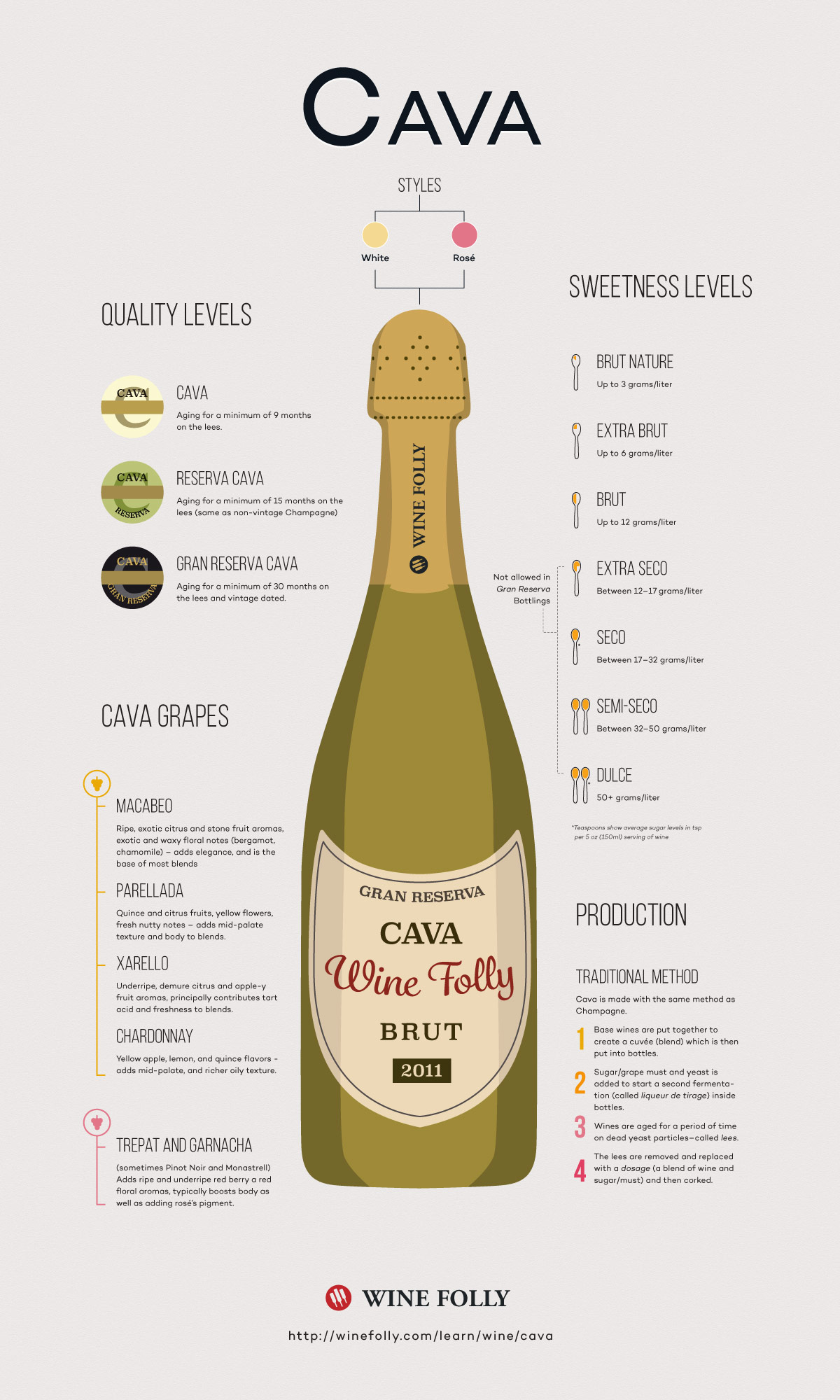WHAT IS CAVA? IS IT CHAMPAGNE?
A lot of people want to know more about Cava. Is it Champagne? What is the difference between Cava and Champagne? What is Prosecco?
First it is necessary to understand Champagne, since sparkling wine as we know it today is generally accepted to have been invented and perfected in Champagne, France. Most other sparkling wines in France and in other countries stem from French Champagne. True “Champagne” only comes from the actual Champagne region in France and follows the traditional method for producing it, as well as the traditional grapes for making it. Cava is not “Champagne” and neither is California sparkling wine, even if it is called “Champagne.” We don’t need to go into great detail about the history of Champagne here, but it is probably helpful to know the basics of Champagne to then understand Cava.
There are 3 traditional grapes used in Champagne. They can be used individually, or they can be used 2 or 3 together. The basic, traditional blend of Champagne is of Pinot Noir, Pinot Meunier, and Chardonnay. These grapes are indigenous to the champagne region of France. The method for making Champagne must be adhered to in order for a wine to be officially labelled “Champagne.” It is the “Méthode Champenoise.” This method involves allowing the wine to continue fermenting in the bottle for a period of time (months to years). During this time, the bottles are capped with crown caps (like for beer) to withstand the pressure that is building inside the bottle. The bottles are also slanted down, so the yeasts eventually settled in the neck of the bottle. When the wine is judged ready, the bottles are kept in this position with the yeasts at the neck. Through several different processes, the neck of the bottle is submerged in a freezing solution, which only freezes a few inches of the wine inside at the neck which contains the yeast. Then, with the yeasts trapped in a short plug of ice, the bottle can be turned upright without the yeast swirling into the wine. The crown cap is removed, and as the plug of ice starts to melt every so slightly, the pressure from the gas inside will actually expel the plug. Then, the winemaker can top up the wine with the same wine or can give it a dose of wine with some sugar to increase fermentation or to add sweetness. There are many variations on this step. We are only covering the basics so the essence of real Champagne and the Méthode Champenoise are understood. What is important to know about the Méthode Champenoise is that the bubbles in Champagne occur naturally from the wine continuing to ferment in the bottle, not from some carbonation method of adding CO2 under pressure.
So how does this relate to Cava? Cava in Spain was modelled after Champagne in France. Cava uses mainly traditional, indigenous Spanish grapes; however there are some examples with French grape varieties, such as Chardonnay. Let’s mostly assume though that Cava is a blend of native Spanish grape varieties. The other important point about Cava is that it is made in the Champagne Method. However only producers in the Champagne region may use the term “Méthode Champenoise,” so in Spain it is known as the “Método Tradicional” or Traditional Method.

Then, Cava can come from a few limited, official areas in Spain, not just one area. The most productive area for Cava, and the most renown, is in NorthEast Spain, near Barcelona, or in the area of Penedès. There is also Cava in Rioja, Utiel-Requena, Ribera del Guadiana, and Cariñena. Most Cava in the US or outside of Spain is probably from the area outside of Barcelona, in Penedès, so let us stick to Cava from here. This the home of the major cava brands, such as Freixenet, Segura Viudas, Cristalino, and others. Most of these cavas are made from 2 or 3 grapes. The traditional, native grapes for Cava are Viura (aka Macabeo), Xarel.lo, and Parellada. There are cavas that are all three, or just two, and in some cases just a single grape variety. We will go into various types of Cavas separately, such as Semi-seco, Brut, Brut Nature, Reserva, etc.
Cava is probably the most Champagne-like sparkling wine outside of France that uses different grape varieties than the Champagne ones. There are non-Champagne wines in France that use the same grapes as Champagne, so yes, they can be even closer to Champagne. However, Cava is truly Spanish, and is usually a good value for the price – especially given the Método Tradicional used to produce it. Cava can also be appreciated for its own distinctiveness.
Lastly, what about Italian Prosecco or California Champagne? Quickly about Prosecco, most people do not know that “Prosecco” is the grape used to make this bubbly wine. It comes from the area around Valdobbiadene in Italy. Prosecco is usually a bit sweeter, is simpler, and is not as Champagne-like as Cava.
“California Champagne” is a term that has been mostly phased out as international trademark rights are being inforced. It is now referred to as California Sparkling Wine. Its definition was not narrowly defined. Very inexpensive Calfornian sparkling wine may not be made in the Champagne Method; it might be fermented in tank, then bottled adding CO2 to make it bubbly. It probably comes from the grape varieties used in Champagne though: Chardonnay, Pinot Noir, and Pinot Meunier (most likely the first two). More expensive California Sparkling wine nowadays is probably modelled on real Champagne, being made in the Champagne Methode and using traditional Champagne grape varieties.
Wow, so cool! Thanks for posting this! <3 :))))
I am glad that you like it :)
Hi! I am a robot. I just upvoted you! I found similar content that readers might be interested in:
http://www.spanishwine.com/information-wine/what-is-cava-wine/
Nice post man ! I voted you up :) Follow me, I'll follow you.
Thanks, now following you